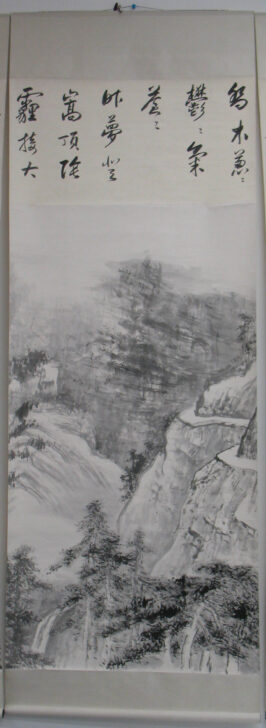Ali Mountain Based on Sketches – 2
Chang Ku-nien

Description
Chang Ku-nien
China, 1906–1987
Ali Mountain Based on Sketches
1965
Hanging scroll, ink on paper
Gift of Ted and Syauchen Baker, 2006/1.136–141
Ali Mountain is one of Taiwan’s most famous scenic landmarks. It is
known for the beautiful “sea of clouds ” surrounding the peaks and the
towering “divine giant trees” punctuating the mountain’s ridges and
the valley. Chang Ku-nien vividly captures these distinctive features by
using very wet ink washes for the misty clouds and drier brushstrokes
for the large pine trees. Together these six paintings form a “screen of
connected scenes” or “sea curtain,” a traditional mounting that allows
the artist to present a panoramic view of a monumental landscape.
Though the ostensible subject of the paintings is Ali Mountain, the
text in running script along the top describes a forested mountain in
mainland China filled with vigorous energies. Chang, a nationalist
born and trained as a literati-style painter in China, was forced to
move to Taiwan after the communist revolution. The literati-style
landscape, the classical lyrics from the Song dynasty (960–1279)—
considered the pinnacle of literati culture—and Chang’s history
combine to make this painting a political statement.
2021 Gallery Rotation
__________
Ali Mountain, located in the central part of Taiwan, is one of the country’s most famous scenic landmarks. It is best known for the beauty of the vast “sea of clouds ” surrounding the peaks and the towering “divine giant trees” punctuating the mountain’s ridges and surrounding valley. Here Chang vividly captures these distinctive features by using very wet ink washes for the misty clouds and drier brushstrokes for the large pine trees. These six paintings together form a “screen of connected scenes” or “sea curtain,” a traditional type of mounting that allows the artist to present a panoramic view of a monumental landscape. Each of the individual panels was painted lying flat on the ground in the artist’s studio, then the inscriptions were added at the top by the artist himself, and finally they were mounted together.
Though the ostensible subject of the paintings is Ali Mountain, the inscriptions in running-script calligraphy (xingshu) reveal that this painting in the traditional literati mode is also a commentary on whether Taiwan (the Republic of China) or the People’s Republic of China is the true inheritor of Chinese culture. Chang, a nationalist born and trained as an artist in China, was forced to move to Taiwan after the communist revolution on the mainland. The inscriptions describe a dream-state in which the speaker looks through dark rainclouds toward his lost homeland and imagines one day recovering it.
(Gallery Rotation Fall 2011)
Subject Matter:
Located in middle-Taiwan, the Ali Mountain is one of the most famous scenic landmarks among Taiwan’s National Parks. Ali Mountain is best known for the beauty of the vast “cloud sea” surrounding the mountain peaks and the towering “divine giant trees” found amid the ridges and valley of the mountain.
The painting’s format, a traditional mounting style called “the screen of connected scenes” or “sea curtain”, gives the artist the advantage of representing a panoramic view of monumental landscapes. Each of six individual pieces was first painted on the ground in the artist’s studio with an overall composition envisioned in the artist’s mind. Then, the inscriptions were added on the top, (inscribed by the artist himself in this case), and finally the six paintings were mounted into the current format.
Inscribed is a piece of classic Song lyrics (the most popular in the Song dynasty), written in calligraphy style running script. The poetic lines describe a forested mountain filled with vigorous energies. Yet the atmosphere is melancholic. The vast landscape appears dream-like, symbolically representing the lost homeland of Chang and his peer generation-- mainland China-- that awaits its recovery from the Chinese Communists. The inscription thus connects the painting’s otherwise natural scenery to the advocated political theme of the Nationalist government’s rule in Taiwan in 1960s.
Physical Description:
One of six hanging scrolls in a series depicting the landscape of Ali Mountain, trees and hillside are shown below calligraphic text. The artist uses alternating wet ink washes for the misty clouds and dry flying-brushes for the large pine trees
Usage Rights:
If you are interested in using an image for a publication, please visit https://umma.umich.edu/request-image/ for more information and to fill out the online Image Rights and Reproductions Request Form.